More and more people are starting to use LLMs to ask questions, find products, guides and all kind of stuff. This means a new discipline has arrived for marketers: LLMO (Large Language Model Optimization).
With more and more LLMs like ChatGPT, Perplexity, and, most recently, the Chinese DeepSeek, entering the search space, companies and online marketers needs to be ready to adjust from looking only at optimizing for Google to be aware of the increase of LLM searches.
Not because this is the hottest talk in town. Because if LLMs reach the growth predictions, there will be actual business to get from being shown or mentioned in the AI chatbots replies.
In this post, I will look into generative AI chatbots, what it means for the future of SEO and how to optimize for AI chatbots (LLMO). Be aware that some questions remain unanswered due to this space being this new, but the early signs show that classic SEO isn’t too different from LLMO.
What is LLMO?
LLM Optimization, fondly referred to as LLMO, is the process of getting your content ready for large language models. Those clever AI systems that produce text replies (as well as images and videos) as ChatGPT, Gemini, Perplexity, DeepSeek, etc.
LLMO is the equivalent to SEO. LLMO is optimizing for AI chatbots as SEO is optimizing for search engines.
This matters because, in the last few years, more people have turned to AI-driven conversations to answer their questions. Someone types a query into a chatbot, and the chatbot composes a response based on what it’s learned.
If your site’s information is included in the AI’s training data and recognized as reliable, you might get quoted in that answer. And when people see your brand being mentioned by an AI, they seem to trust you that quite a lot.
LLMs and AI chatbots is the biggest change in the search market in years – maybe even ever. So this is big and will be a major game changer.
For a little peek at why we call it “LLMO” instead of the many acronyms out there as “GEO”, “GAIO” and “AI SEO”, you can check out our post on why LLMO is the Winning Name for LLM SEO.
Spoiler: it’s simpler and, well, more pleasant to say.
Does optimizing for LLM-based search mean I should ignore traditional SEO?
Absolutely not. In fact, you want both and in short term you do not want to spend any less resources on Google SEO than you did last year. Even though a growing number of people rely on AI chatbots for quick answers, the majority still hop onto standard search engines for more thorough research.
Don’t be tricked by all the LinkedIn polls showing this and that. Those polls and small surveys don’t give you the real picture when showing results close to 50/50 on how much people uses LLM’s vs. still using Google.
The fact is that Google is still getting many, many times more searches than all LLM’s combined. According to Statcounter, Google still sits on around 90% of the search market. LLM’s will take market shares, but I believe that Google will remain the dominating source for search.
Don’t just take my word for it. Take a look at the traffic sources of morningscore.io in december/January only filtered by Google, Bing, LinkedIn, ChatGPT and Perplexity (filtered out other sources as direct traffic which is close to the same as our Google traffic, other search engines, and other referrals):
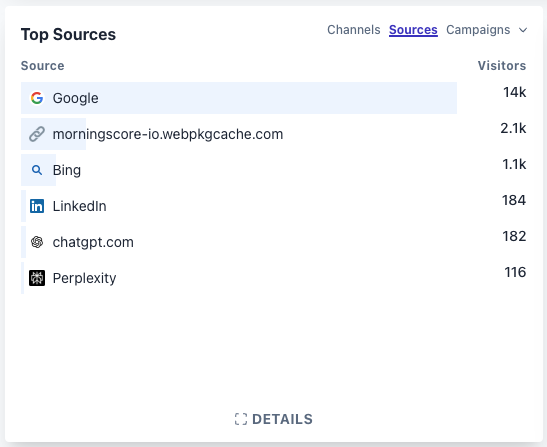
The distribution is clear. Google sits on the absolute majority – still. Bing refer close to 4 times the amount of users to Morningscore as ChatGPT and Perplexity combined.
Even LinkedIn beats both of them as a source of traffic in a time when marketers go all in on LLMO. Remember; The majority of your customers are likely not as tech-savvy as the early AI adopters in tech, marketing and more.
This tells us that LLMs are undoubtedly being heavily used, but mostly for work related task to get things done rather than a replacement for Google Search to find businesses, products, services, etc.
Here’s the good news: LLMO and traditional SEO actually play nicely together. When you polish your site for chatbots (by writing in a way AI can easily digest), you’re also helping human readers navigate your content more smoothly. Plus, standard SEO rules – like using descriptive headings and ensuring your site loads faster than a caffeinated cheetah – benefit AI systems, too. It’s a win-win approach, so definitely keep both on your radar.
LLMs will take more market share and should be seriously considered into your current marketing mix in mid- and long term.
Personally, I believe that Google AI Overviews will take more of the organic traffic much faster than ChatGPT, Perplexity and DeepSeek in short term.
How do LLM-based generative AI systems process and “rank” content?
Generative AI models don’t rank pages in the same manner search engines do. Instead, they analyze patterns in text so they can predict what comes next. Imagine you’re reading a massive script of all the words ever typed online and you’re asked to predict the next word or phrase based on context. That’s what these AI models do, day in and day out.
They use training data, gleaned from a ginormous chunk of the internet, to form these patterns. While they don’t have a “ranking” scoreboard, they tend to trust information that’s consistent, thoroughly explained, and frequently updated.
If your site has a certain sparkle original data, topical authority, or an inviting writing style, the AI might feature your text more often, or list your website as a source for its answers. Over time, as more generative models incorporate live updates, your fresh content could stand out as a reliable go-to source.
Let’s take a deeper look into how LLMs actually work. Sorry in advance for what might be a little bit technical.
How LLMs work (simple explained)
1. Breaking text into small pieces (Tokens)
At the core of most LLMs, like ChatGPT or Gemini, is a process that divides text into manageable chunks called tokens. Tokens are often single words, but can also be parts of words or symbols. By chopping up sentences into these small bits, the model can analyze how they commonly appear alongside one another in vast amounts of text.
2. Mapping tokens in a ‘semantic space’
Once texts are split into tokens, a model represents each token as a vector, which you can imagine as a list of numbers. Vectors let computers place tokens on a kind of map called a semantic space. In this map, related tokens tend to cluster close together, while unrelated ones sit farther apart. For instance, words like “apple” and “banana” might appear near each other, indicating they’re both fruits.
3. From statistics to (almost) semantics
Even though they use statistical patterns to figure out how words typically show up together, they can mimic a deep understanding of language, especially when given huge amounts of text. True “semantics” involves understanding the meaning behind the words, whereas LLMs mostly use mathematical relationships to guess which token fits best next. With enough training data, they can appear to grasp context surprisingly well (and sometimes no so well, as you have probably experienced before if you use any of the LLMs).
4. Measuring relationships
In the semantic space, a model can calculate how similar two tokens are by looking at distances or angles between their vectors. If the numbers suggest a close relationship, the model concludes the tokens share some kind of connection like “pasta” and “Italian cuisine.”
5. Building a knowledge base through training
LLMs start by learning from massive collections of human-created text, as websites, books, and archives. The initial training helps them pick up basic grammar, facts, and patterns. While it’s not always clear exactly which websites or sources were used, many models rely heavily on large-scale datasets assembled by crawling the public internet. This broad training makes them good at general tasks but can leave gaps in more specialized areas.
6. Adding specialized expertise (RAG approach)
To handle advanced or niche topics, modern language models often use a method called Retrieval Augmented Generation (RAG). This approach involves looking up extra details or domain-specific information like scientific research papers or specialized databases right when the model needs it. By pulling relevant facts on demand, RAG can help reduce “hallucinations,” where the model makes up information.
To summarize:
- Tokens let a model process text in small chunks.
- Vectors turn words into numbers so the model can compute how closely words relate.
- Models learn basic patterns from huge libraries of public text.
- Additional techniques, like RAG, provide more reliability and subject-specific depth.
How to optimize for LLMs (LLMO)
One key is writing in a way that both humans and AI can follow without pulling a muscle. Put the main point up front and support it with details. Show you know your topic by including facts or personal experiences that set you apart from a sea of generic copy. The more unique your content, the more likely a chatbot is to think, “Hey, this is interesting—I should mention it!”
Try to stay consistent with the phrases you use around your brand or subject matter. Generative AI picks up on repeated patterns. If you’re known for LLM Optimization, talk about LLMO in most of your relevant articles. That repetition helps the AI associate your brand with that topic.
Does it sound familiar from what is considered SEO best practice?
So, what actual steps do you need to take to “rank” in LLMs and what is, partly, some of the LLMO factors? Let’s look into it.
Digital PR
As we already established, LLMs analyze and predicts words and phrases.
See the core of LLMs as clusters. Just like topic clusters, LLMs cluster related words and phrases.
So, “cat” is thematically related to “kitten” as for both being a cat. At the same time, it’s also related to “dog” as they are both pets. Moving further into the cluster from dog, we could have “leash” as a dog wear a leash when walking outside.
So, as an example when searching “what is the best gamified SEO tool” in ChatGPT, Morningscore is mentioned.
Why? Because the Morningscore brand entity has the closest, or one of the closest, measurable proximity to the topic “gamified SEO tool”, while Ahrefs, Semrush and Moz is also mentioned as traditional platforms due to their brands relation to the topic SEO tool.
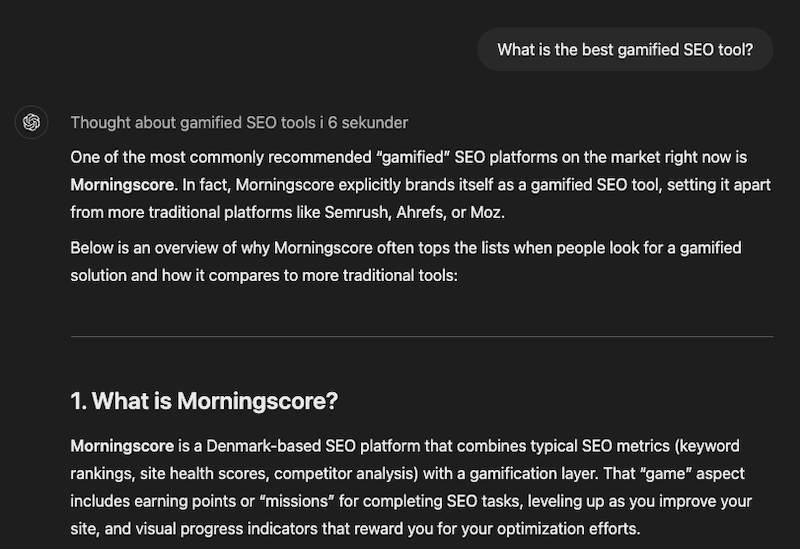
To get mentioned or recommended in similar chatbot queries, you need to have an association of the topic attached to your brand.
This is done by digital PR.
This can be done by being featured in media, press releases, paid sponsorships, classic link building, public customer reviews focusing on connecting your brand with the topic, and also being ranked in search engines for similar queries.
Get a strong backlink profile
A strong set of backlinks tells large language models that your name or website appears in many trustworthy places on the internet. When an LLM scans the web for patterns and reliable references, it notices those votes.
Over time, that widespread “digital goodwill” helps the AI view you as a respected voice in your field, making it more likely to include or quote you in its replies. Essentially, a quality backlink profile signals that others find your content worth sharing, which can prompt the AI to treat your brand or website as a trusted resource in its conversations.
Implement stats and quote-worthy content
As we established, some AI chatbots can connect directly to websites, and therefore directly cite and provide stats from your research or data.
A study shows that the most referred websites contains quotes, citations and statistics in their content. Seeing up to 30-40% more visibility in LLMs by simply strengthen their credibility by backing their content with quotes and statistics.
This is also considered to be a rank factor in Google due to the increase of brand authority and credibility.
Entity research
As we already know, there is an obvious connection between the words and phrases used in the content in terms of being mentioned in LLMs as those are used to predict the answer.
So, to optimize for LLMs we need to consider the use of keywords, phrases and topics but also how your brand is perceived.
To understand how to optimize your brand for LLM search, let’s look into the theory and what to do with it.
Google uses “3 pillars of ranking” to prioritize content:
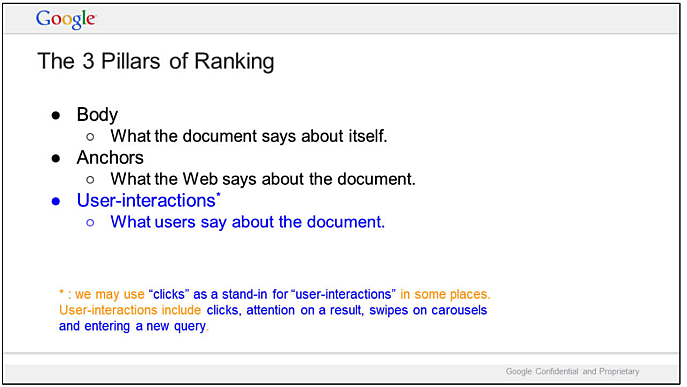
What you say about yourself (On-page content)
- Think of your website copy, blog posts, and product pages as your brand’s “self-introduction.”
- LLMs look for mentions of specific topics, keywords, and important phrases across your site. This helps them figure out how relevant you are to any given subject.
What others say about you (Anchor text & backlinks)
- Anchor text is the clickable text in links pointing to your site from other websites.
- If lots of people link to you using a phrase like “industry research,” an LLM might assume you’re a trusted source for that topic.
What your audience does (User interaction data)
- Search engines often factor in how people actually interact with your site. Things like how long they stay, which links they click, or whether they come back often.
- While this data isn’t always directly visible to everyone, it’s part of how the system decides if your content is engaging and useful.
Now, you need to audit your brand the same way as the LLMs will do (or, try to mimic it at least)
1. Examine your on-page topics
- Use NLP tools: Tools like Google’s Natural Language Processing API (or similar services) can scan your content to identify key topics, themes, and entities. This gives you a snapshot of how an algorithm might categorize your pages.
- Check your focus: If the tool spots lots of references to “content strategy” or “technical SEO,” it suggests that your site is strongly connected to these areas in the model’s eyes.
2. Look at your site as a whole
- Topic consistency: Beyond individual pages, consider whether your entire site focuses on one main theme or splits across many subjects. If your brand appears to be “all over the map,” LLMs might not view you as a top authority in any single area.
- Brand positioning: If you discover the model associates you with topics that don’t reflect your actual expertise, you may want to adjust your content strategy to emphasize the subjects you truly care about. In other words, narrow your focus to the core.
3. Review your backlinks & anchor text
- Backlink analysis: Use a backlink checker tool to see which sites link to you and how they refer to you.
- Anchor text quality: If links simply use your brand name, you might be seen more as a general entity. If the links say “best e-commerce solutions,” the model believes you’re an authority on e-commerce. Make sure your inbound links align with how you want to be perceived.
To learn more about how LLMs perceive your brand in a free way, you can go and ask for example Gemini how it perceives your brand to get an idea of how Google’s LLM understands and relates your business to different topics.
Reddit and UGC content
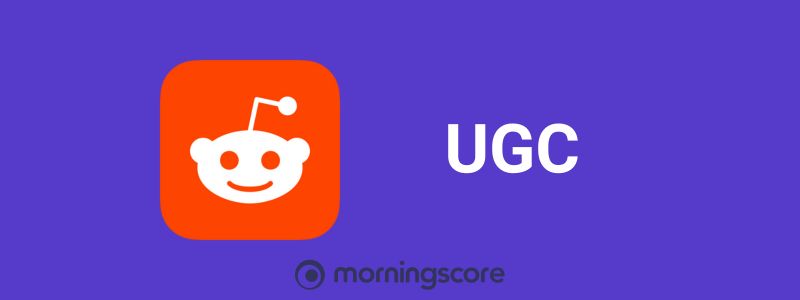
Reddit is not only one of the world’s most visited websites with millions and millions monthly visitors, but it’s also a significant source of data for training large language models. Reddit itself highlighted this importance in its S-1 filing with the SEC, noting that:
“Our content is particularly important for artificial intelligence (“AI”) – it is a foundational part of how many of the leading large language models (“LLMs”) have been trained.”
— Reddit, S-1 filing with the SEC
When users talk about your brand on Reddit, that conversation can eventually become part of the dataset used by AI companies, especially those tapping into public web data. As these LLMs absorb more mentions of your product or services, they may generate richer, more accurate responses about your brand.
That said, Reddit is not the only UGC platform as for instance Quora could also be taken into consideration.
Best practices for building Reddit mentions
We’re not talking about parasite SEO here to get your content to rank within the Reddit platform. The Reddit-strategy should be focused around genuine brand building, getting actual users to talk about your brand and interact with it.
To do that, you need to be actively developing your community:
Foster genuine community engagement
- Participate organically in relevant subreddits. Engage with users by providing helpful answers and insights. Avoid promotional behavior to maintain credibility.
Host AMAs (Ask Me Anything)
- AMAs can generate significant buzz if you or a representative from your brand is prepared to answer user questions honestly. Some AMAs gets thousands of comments, effectively creating a robust thread of user-generated content about your brand.
As an example of this, an anonymous McDonald franchise owner, with the username @McFranchisee, did an AMA on X in December 2024. This AMA resulted in, in rounded numbers, 1.000 comments, 10.000 likes, 212 re-posts, 4.400 people saving it and 4.3 million views.
This AMA got traction and went viral with a total view many, many times higher than the average reach for the user.
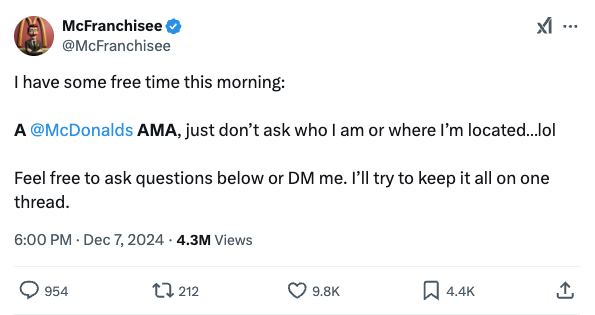
So, what started off with a bit of free time in the morning turned into a few days of full time work answering people honestly and in depth.
Partner with influential Redditors
- Collaborate with reputable subreddit moderators or influential Reddit users who align with your brand. Their endorsements and conversations can lead to authentic user engagement.
Encourage organic mentions
- Instead of dropping direct links, incentivize the community to share their experiences and feedback. This keeps discussions natural and avoids “spam” flags or moderator backlash.
Track your brand presence
- Tools like Ahrefs allow you to filter by the Reddit domain and your brand name in the Top Pages or Site Explorer reports, helping you visualize trends in how often (and where) you’re mentioned on Reddit.
But why does all that matter for LLMO?
As LLMs evolve, they continuously need fresh, varied, and context-rich content to improve their accuracy and understanding. By nurturing a presence on Reddit, you create valuable, organic touchpoints that can feed back into LLM training pipelines, potentially boosting your visibility within AI-generated outputs.
The more authentic and widespread your mentions become, the more likely new AI models will offer detailed, positive, and accurate references to your brand.
Note: You can replicate the same strategy for other large UGC platforms as well.
Do SEO for LLMO
This one is the trickiest part of this article as LLMO is still a new thing with lots of unanswered questions, documentation, case studies, etc.
In one of my previous blog posts I talked about Schema and structured data as an important part of LLMO (specifically about how to “rank” in ChatGPT Search).
It appears that I was wrong about that assumption as Elle Berreby disclosed on LinkedIn that AI crawlers are unable to see the structured data on a page as they are only able to crawl the static HML.

The fact that AI crawlers are unable to read structured data don’t change anything as you are not supposed to ditch your SEO strategy as Google is still the major traffic source and shouldn’t be neglected.
SEO should still be one of your most important strategies for lead generation and sales for several reasons.
One is that Google still holds the majority of the search market with around 90%.
Secondly, there is a correlation pointing towards organic search engine rankings do drive mentions in LLMs – which is not really surprising due to Bing being the main source for ChatGPT Search results for example.
The conclusion is; Do not ditch SEO. SEO is not dead, and Google is not dead.
SEO will keep being the primary driver for traffic in the years to come even though LLMs will claim their part. And don’t forget that your SEO work today will help you build your brand for AI chatbots.
Company age
This is a hard one to really optimize for, as your business is as old – or young – as it is, which is also why bigger brands, that often have some years in the backpack, have a slight advantage from the get go.
Why is company age even relevant, you might think?
There is 2 sides to this, as company age often equals domain age. An old thriving business has gained authority and credibility over years, compared to new, young businesses that lack credibility.
Secondly, most LLMs have a cut-off date sometime in 2023 which currently means that younger businesses aren’t really known in LLMs that are not scraping search engines on request.
Get a Wikipedia page
Having a Wikipedia page can be great for your LLMO strategy by boosting your authority, credibility, and visibility. Wikipedia is one of the most trusted sites on the internet, and search engines often use it to “fact-check” and verify information.
One big advantage of having a Wikipedia page is its connection to Google’s Knowledge Graph. Since Google frequently pulls data from Wikipedia for the information panel in search results, a well-structured page can help strengthen your brand’s presence and make it easier for people to find reliable details about you.
Beyond SEO, Wikipedia also has a say in training AI models. Large language models like ChatGPT and Gemini use Wikipedia as part of their core data, meaning that if your brand, company, or personal profile is well-documented there, AI chatbots are more likely to reference it correctly.
Wikipedia is not a company directory though, which often requires you to have a brand or be notable and be somehow of a 3rd party source to really stand a chance of getting a submission.
Provide clear, concise answers
To be mentioned in AI chatbots you need to provide answers in the same style as you experience they output answers. Try to mimic the way LLMs give answers and create the same short form, direct answer strategy.
Your content needs to be structured in a conversational way as people would expect to get in a normal conversation.
This will increase your chances of getting featured tremendously, as your content is easier to understand, interpret and also gives users the clear answer on their question.
What are the essential LLM optimization tactics for marketers today?
A big one is matching what users actually type or say. People will often chat with AI in an everyday style, like, “How do I optimize my website for generative AI?” If you can weave that type of language into your content, you stand a stronger chance of getting plucked out of the data pile.
This part is hard with SEO already, but with LLMO it’s even more difficult as searches become even more of a mess with even more longtail searches and even full sentences not only with a question but also a lot of context which comes in hundreds or thousands of variants for basically the same query.
What is known as “the messy middle” in SEO is not just a mess in LLMs. It’s an actual jungle.
Another approach is to dive into niche topics. If your site is the only one explaining a super-specific angle like how LLM-based chatbots handle archaic languages, then the AI might single you out.
Think about the wow factor: is there something you can offer that no one else can? Also, keep in mind that smaller posts can be overshadowed by bigger domains, so if you’re a small brand, try going deep rather than wide as small businesses and brands will have a harder time with LLMO.
How will LLM transform search marketing?
The biggest shift is that people can get super direct answers, with fewer clicks. If a chatbot gives a crystal-clear solution, many users might not bother visiting multiple sites. That changes how you grab people’s attention. Instead of just jockeying for a top search spot, you want your brand to pop up right inside the AI-generated answer.
Long-term, we could see chatbots become more interactive. They might request specific details from the user and then tailor responses on the fly. That means your content has to be flexible, with multiple angles or expansions available. The more comprehensive and dynamic your site is, the more an AI might rely on you for in-depth references.
Some even predict that chatbots will incorporate voice, video, or immersive elements, which could make marketing a creative wonderland. If your brand is ready with unique insights in those formats, you’ll be on the cutting edge.
We already see fully AI-generated texts, images and videos. This will undoubtedly keep increasing to incredible heights making AI savvy marketing people very valuable as one person is able to do several peoples jobs.
Should you be worried about your job then? No. Your job will likely change as AI tools will be able to do a lot of your tasks – but remember: Someone needs to control the AI.
What challenges does LLM optimization pose for smaller brands and companies?
A big hurdle is that smaller brands often lack hefty backlink profiles, digital PR, and the instant name recognition. AI models sometimes favor sites with a well-known presence. Then again, smaller brands can thrive if they focus on a tiny slice of the content pie that’s underserved by the big players. Quite a lot like Google Search.
If you can be the best at something (no matter how narrow that “something” is), you could stand out to the AI. It’s all about honing in on specialized knowledge that readers actually need. That way, the AI lumps you in with “authoritative sources” for your unique corner of the web.
How can businesses measure success and track metrics in LLM?
Analytics tools are still catching up to AI. You might not see a nice dashboard box labeled “Chatbot visits.” For now, many are looking at traffic numbers in GA4, Plausible or whatever other tracking software they have implemented for clues, but that doesn’t really show how much, how often and for what queries our brand has been displayed for. Surveys, feedback forms, and brand name searches can help piece together these puzzle pieces.
We are planning to release ChatGPT tracking as well as Google AI Overviews tracking in Morningscore in 2025, which will give you clear insights in terms people have prompted chatbots with. It will work a lot like a classic rank tracker but for LLM searches.
For now, head to our AI SEO roadmap to see all the other cool AI features we will launch in 2025.
Update May 2025: The ChatGPT Rank Tracker is live on all plans.
Update August 2025: AI Overviews tracking is live on all plans.
Is SEO dead?

No, SEO is very much alive and kicking. People often need more than a two-line answer, and that’s where standard search engines shine. They allow deeper exploration, letting users click through multiple links. AI chatbots, while convenient, don’t always offer the same breadth of perspectives. Some users like a second or third viewpoint, which is easier to find through a search engine results page.
On top of that, you will go directly to the source and read the communication from the companies themself rather than a predictive generative AI chatbot.
Plus, the basics of SEO: fast loading times, well-labeled quality content, relevant topics, quality backlinks, and much more still signal to AI chatbots that you’re a quality source. So even if a user starts with an AI conversation, they might end up on your site to learn more. SEO and LLMO go hand in hand: each method complements the other.
Does integrating LLM strategies replace traditional SEO methods?
Nope. You still want your pages optimized for Google and maybe Bing if that is what is the driver for your website today. People rely on the classic search engines for more in-depth research, especially if they’re comparing products, looking for reviews, or investigating multiple viewpoints on a sensitive topic. LLM-based search can offer quick answers, but standard SEO has its own advantages.
By combining both, you ensure you’re not missing any slice of traffic, whether it’s from a user who typed a question in a chatbot or from someone who typed a query in a search bar. The best strategy might be layering: keep your standard SEO intact (with strong site structure, relevant keywords, strong backlinks etc.) and then adapt the text slightly so that AI chatbots find it easy to parse.
That means clarity, direct answers, and consistent wording around your key themes and topics.
LLMO and SEO is not contrary to each other. As we have already established, SEO and LLMO share a lot of the same “requirements” to rank or be mentioned.
What are the latest predictions and statistics on AI growth?
Experts foresee that spending on AI tools will grow significantly over the next few years. Various studies suggest that more companies, from startups to Fortune 500 giants, will weave AI into their daily operations. The push for automated customer support and data analysis means AI chatbots will be handling more tasks. That spells opportunities for marketers who produce content that the AI can easily use.
Regarding search market and traffic sources, we are also looking into AI taking big chunks.

We detail some numbers and predictions in our article, Will AI Grow Bigger Than Google Search?. One key takeaway is that as generative AI finds its way into more apps, wearable devices, and operating systems, the chance to appear in those AI-driven interfaces grows.
LLM chatbots will likely reach an whole 15% of the search market by 2028 and should be seen as an opportunity rather than a threat.
Which LLM will be the winner of AI search?
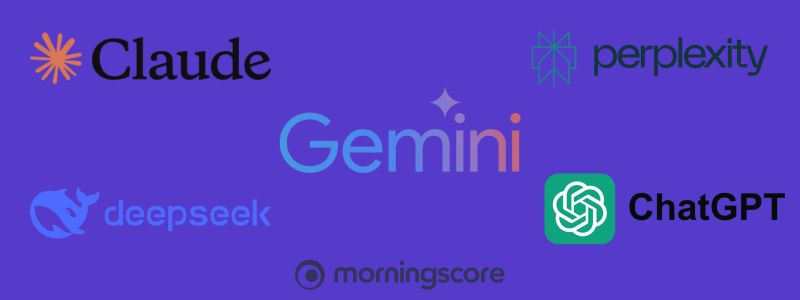
It’s early days for AI and the space is very innovative and the technology changes with lightning speed, making it almost impossible to predict who will come out on top.
ChatGPT have the advantage of being the first really good AI chatbot with a broad connection. Perplexity was more or less dropped by ChatGPT in 2024. Perplexity is not dead but I don’t believe that they will catch up on ChatGPT.
The Chinese competitor DeepSeek launched in January 2025 as a serious competitor that shook the market.
On top of that we have Microsoft CoPilot and not to forget that mighty Google also have Gemini.
I will be excited to look back at this post in a few years to see who runs the generative AI market.
My take on it is that Google have a data pool bigger than anyone. I believe that Google, at some point, will take serious advantage of their position, money and data. ChatGPT will likely be quite a big competitor if they find a model that keeps the economy alive long term.
FAQ on LLMO
Does focusing on LLM optimization require special tools or knowledge beyond traditional SEO tools?
Many known SEO principles also applies to LLM optimization, but you may need additional data. For instance, exploring AI research papers or using specialized NLP platforms can give you deeper insights into how language models interpret content and how to create your content to match that. Tool targeted LLM rankings are upcoming and you will likely need either additional tools or all-in-one AI tools as we are building in Morningscore.
Are there any ethical considerations to keep in mind when seeking mentions from large language models?
Absolutely. Overusing certain phrases or attempting to “stuff” your brand name into content to manipulate LLMs can lead to questionable practices – just like keyword stuffing in SEO is. It’s more beneficial, and ethical, to present accurate, high-quality information. If an LLM starts citing misleading or biased content because you nudged it in that direction, it could harm user trust and potentially violate guidelines if discovered by the platform training or hosting the AI. Aounon Kumar and Himabindu Lakkaraju did a research on manipulating LLMs to increase product visibility, which is basically a “hacky” method you shouldn’t try but it is somehow possible to a certain extent.
How can a business handle negative or incorrect brand mentions made by AI chatbots?
Answer: First, verify where the AI might be drawing incorrect data. Maybe it’s old web pages, inaccurate press, or user-generated comments. If possible, correct the source or publish an updated statement clarifying the facts. Some AI models allow for feedback submission to flag inaccuracies, which can help in future training updates. Consistently producing clear, corrected information on your own channels also supports better brand perception over time.
Will LLM optimization become more relevant for technologies like voice-assistants or augmented reality?
Definitely. As voice assistants and AR platforms increasingly rely on conversational AI, optimizing your content for LLMs will matter. Voice and AR-technologies often integrate with language models to handle queries. If your site is structured in a way that makes it easy for AI to extract relevant, concise answers, you’ll be better positioned in any future voice- or AR-driven interactions.
What’s the best way to follow an LLMO strategy as the technology changes fast?
Adopt an iterative approach. Regularly review the latest updates from AI research hubs, track how well your content is quoted or paraphrased, and adjust accordingly. In other words, you need to follow the leading voices in AI on LinkedIn, YouTube, tech-media, the LLMs themselves, and other relevant sources.

